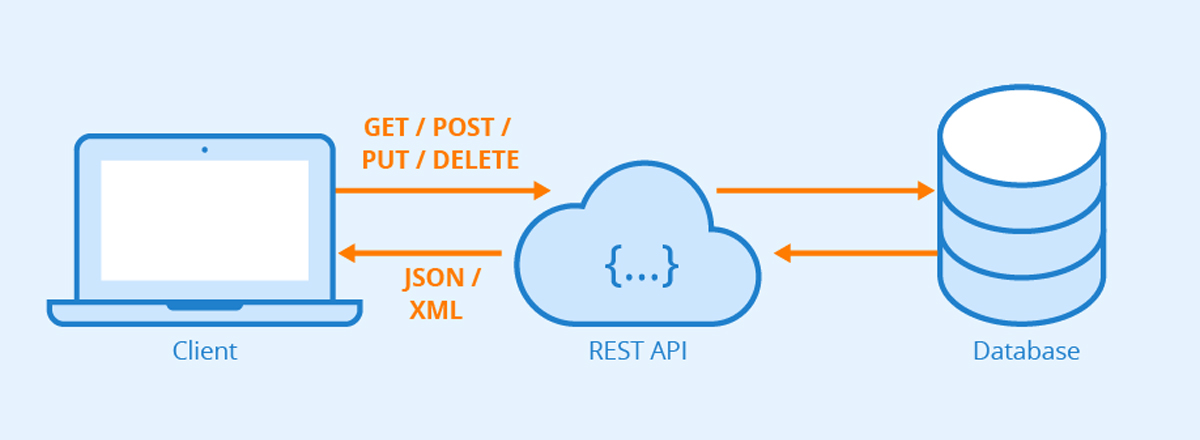EXPLORING RESTFUL APIS IN DETAIL FOR WEBSITE DEVELOPMENT
REST is an architectural style for designing networked applications. restful APIs use standard HTTP methods (get, post, put, delete) to perform operations on resources. this pattern is widely used for building web services that are scalable and easy to consume in a custom logo design.
1. Architectural Style
REST, which stands for Representational State Transfer, is not a protocol but an architectural style that provides a set of principles for designing networked applications. It was introduced by Roy Fielding in his doctoral dissertation in 2000. RESTful APIs, as a practical application of these principles, are important for an affordable logo design service and help, adhere to a set of conventions that make them scalable, flexible, and easily consumable.
2. Resource-Oriented
At the core of RESTful APIs is the concept of resources. Resources represent entities or objects in the system, and each resource is uniquely identified by a Uniform Resource Identifier (URI). These resources are manipulated using standard HTTP methods, providing a uniform interface for interaction.
3. Standard HTTP Methods
RESTful APIs use standard HTTP methods to perform operations on resources. The most commonly used methods are:
- GET: Retrieve a representation of the resource.
- POST: Create a new resource.
- PUT: Update or create a resource.
- DELETE: Remove a resource.
4. Stateless Communication
RESTful communication is stateless, meaning that each request from a client to a server contains all the information needed to understand and process the request. The server doesn't store any information about the client between requests. This statelessness simplifies server implementation and improves scalability through a unique logo and brand identity design.

5. Representations
Cheap logo design deals with resources in a RESTful API can have different representations, such as JSON or XML. Clients can specify the desired representation through the HTTP "Accept" header. This flexibility allows for compatibility with various client types, including web browsers, mobile devices, and other applications.
6. HATEOAS (Hypermedia as the Engine of Application State)
HATEOAS is the best logo design help principle that suggests including hypermedia links in the API responses, allowing clients to navigate the application state. These links guide clients to discover available actions or resources dynamically, reducing the need for a priori knowledge about the API structure.
7. Scalability and Simplicity
RESTful APIs are known for their scalability and simplicity. The stateless nature and adherence to standard HTTP methods simplify the architecture, making it easier to design, implement, and maintain. This simplicity contributes to the widespread adoption of RESTful APIs in web development.
8. Resource URIs
URIs are used to uniquely identify resources. Buy a logo design service to help you with well-designed URIs that follow a hierarchical and consistent structure, making them predictable and easy to understand. For example, a RESTful URI might look like: https://api.example.com/products/123
9. Caching
RESTful APIs leverage HTTP caching mechanisms to improve performance. Responses can include caching directives, allowing clients to cache representations and reduce the need for repeated requests to the server.
10. JSON as the Preferred Format
- While RESTful APIs can support multiple representations, JSON a format for logo design service online has become the preferred format for data exchange due to its simplicity, readability, and widespread support in modern web development.
In conclusion, RESTful APIs provide a standardized and scalable approach to designing web services. By leveraging the principles of REST, developers can create interoperable and efficient APIs that are well-suited for a wide range of applications, from small-scale projects to large-scale enterprise systems.
Related Bolgs
- VISUAL STORYTELLING: USING DESIGN TO CONVEY YOUR BRAND'S NARRATIVE
- TIPS FOR DESIGNING SHORT-FORM CONTENT FOR DIGITAL MARKETING
- TIPS FOR USING TIKTOK AS DIGITAL MARKETING PLATFORM
- DOODLES AS EMERGING TRENDS FOR LOGO DESIGN
- Exploring RESTful APIs in Detail for Website Development
- Tips for Photos Manipulation and Editing
- How Hashtags Play a Crucial Role in TikTok Digital Marketing?



